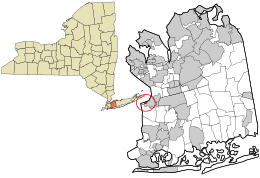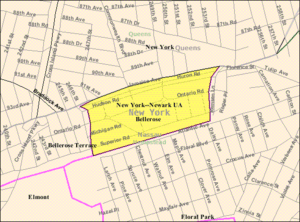Bellerose, New York facts for kids
Quick facts for kids
Bellerose, New York
|
|
|---|---|
| Incorporated Village of Bellerose | |

A village welcome sign at the Bellerose station in August 2022.
|
|
| Motto(s):
"An American Beauty"
|
|

Location in Nassau County and the state of New York
|
|
| Country | |
| State | |
| County | Nassau |
| Town | Hempstead |
| Incorporated | 1924 |
| Area | |
| • Total | 0.13 sq mi (0.33 km2) |
| • Land | 0.13 sq mi (0.33 km2) |
| • Water | 0.00 sq mi (0.00 km2) |
| Elevation | 85 ft (26 m) |
| Population
(2020)
|
|
| • Total | 1,173 |
| • Density | 9,309.52/sq mi (3,605.08/km2) |
| Time zone | UTC-5 (Eastern (EST)) |
| • Summer (DST) | UTC-4 (EDT) |
| Zip Code |
11001
|
| Area codes | 516, 363 |
| FIPS code | 36-05639 |
| GNIS feature ID | 0943608 |
Bellerose /bɛlroʊz/ is a village in the Town of Hempstead in Nassau County, on Long Island, in New York, United States. The population was 1,173 at the 2020 census.
History
The village was founded by Helen Marsh of Williamsburg, Brooklyn. In 1907, planning to build a model community, Marsh purchased 77 acres (310,000 m2) of Floral Park gladiola fields. The first Bellerose home was completed, under Marsh's supervision, in 1910. Marsh persuaded the Long Island Rail Road to place a station in the new village, and she named the station Bellerose. Though it has been suggested that she named the station for the Rose farm, south of the railroad, and her daughter Belle, she said that she simply found the name "euphonious". A vote of the homeowners made the name official in 1917.
Bellerose incorporated itself as a village in 1924 in order to gain and maintain home rule.
The Bellerose Village Hall, Fire House and Police Booth are on the National and State registries of Historic Places; the complex is known as the Bellerose Village Municipal Complex.
Geography
According to the United States Census Bureau, the village has a total area of 0.1203 square miles (0.312 km2), all land.
The village borders Queens to the north, Bellerose Terrace to the west, and Floral Park to the south.
Demographics
| Historical population | |||
|---|---|---|---|
| Census | Pop. | %± | |
| 1930 | 1,202 | — | |
| 1940 | 1,317 | 9.6% | |
| 1950 | 1,134 | −13.9% | |
| 1960 | 1,083 | −4.5% | |
| 1970 | 1,136 | 4.9% | |
| 1980 | 1,187 | 4.5% | |
| 1990 | 1,101 | −7.2% | |
| 2000 | 1,173 | 6.5% | |
| 2010 | 1,193 | 1.7% | |
| 2020 | 1,173 | −1.7% | |
| U.S. Decennial Census 2010 2020 |
|||
2020 census
| Race / Ethnicity | Pop 2010 | Pop 2020 | % 2010 | % 2020 |
|---|---|---|---|---|
| White alone (NH) | 964 | 896 | 80.80% | 76.39% |
| Black or African American alone (NH) | 35 | 36 | 2.93% | 3.07% |
| Native American or Alaska Native alone (NH) | 4 | 1 | 0.34% | 0.09% |
| Asian alone (NH) | 52 | 62 | 4.36% | 5.29% |
| Pacific Islander alone (NH) | 0 | 1 | 0.00% | 0.09% |
| Some Other Race alone (NH) | 5 | 13 | 0.42% | 1.11% |
| Mixed Race/Multi-Racial (NH) | 20 | 43 | 1.68% | 3.67% |
| Hispanic or Latino (any race) | 113 | 141 | 9.47% | 10.32% |
| Total | 1,193 | 1,173 | 100.00% | 100.00% |
Education
It is in the Floral Park-Bellerose Union Free School District and the Sewanhaka Central High School District.
Notable people
- Joanne Persico, volleyball coach
- John P. Shanley (1915-1985), journalist, specializing in radio, television and drama, who spent much of his career with The New York Times.
- Nick Wall, (1906-1983), jockey
See also
 In Spanish: Bellerose (Nueva York) para niños
In Spanish: Bellerose (Nueva York) para niños




